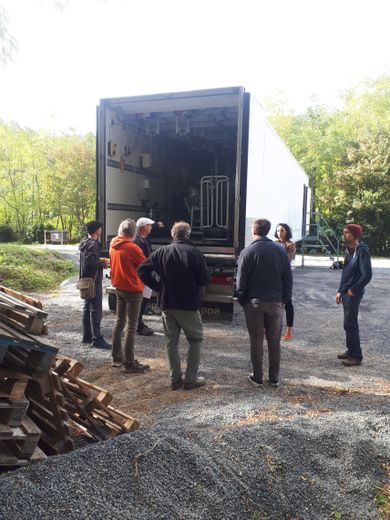The mobile and peasant slaughterhouse of the Lozerian Cévennes hoped for by the summer of 2025

A semi-trailer has already been purchased to accommodate the future mobile and peasant slaughterhouse. – PETR 48
Around twenty breeders created, in 2019, the association Local Cooperative Slaughtering Structure (Slac). Helped in particular by the Sud-Lozère Territorial and Rural Balance Pole (PETR), they hope for a rapid completion of their project. Update on this initiative.
No longer impose on animals long hours of driving to Antrenas or Alès, most often in summer in very hot weather; ;reduce their carbon footprint; manage the entire production chain themselves, without delegating the most thankless task to others; guarantee better quality of the meat… So many reasons which have led to around twenty breeders from the Cévennes to come together to develop a project for a mobile and peasant slaughterhouse, only for sheep and goats.
If it sees the light of day, this equipment will support the cutting and transformation workshop of the Agricultural Equipment Use Cooperative (Cuma ) of Hauts-Gardons, in Sainte-Croix-Vallée-Française. To achieve this, the association Local Structure of Cooperative Slaughter (Slac) was created in 2019. The operators who make it up are mainly based in the Valley French and in the Long Valley, as well as in Vébron, Saint-André-de-Valborgne and around Florac. All hope for commissioning in the summer of 2025.
A mobile slaughtering box from farm to farm
The mobile slaughterhouse will be installed in a semi-trailer already acquired by Slac for some €70,000, and partly converted. "It benefited from temporary approval for the Muslim festival of Eid el-Kebir", specifies Louise Daunizeau, agriculture mission manager at & nbsp;Pôle d'territorial et rural (PETR) Sud-Lozère, which supports the initiative as part of the Terra rural program. "However, it is not up to standard for traditional slaughter. Thirty thousand euros of work is necessary." A shared wastewater treatment plant with the cutting workshop will also have to see the light of day.

A semi-trailer has already been purchased to accommodate the future mobile and peasant slaughterhouse.
In addition to this new tool, where all stages of the slaughter chain can be carried out, Slac wishes to acquire a slaughter box mobile. This would allow stunning and bleeding to be carried out directly on the farm, before evacuation of the animal to the semi-trailer, in Sainte-Croix-Vallée-Françaises, for the others tasks: cutting of legs and skinning, evisceration, splitting, trimming, refrigeration… An investment which would therefore allow breeders to end the days of their animals where they are born and where they have always lived.
Waste recovery
Once its mobile and peasant slaughterhouse is in service, the Local Structure of Cooperative Slaughter association wishes to make the most of the waste, ; start with the bellies, heavy and expensive, to make tripe. To make their work easier, breeders also plan to purchase a laundress.
Many partners
"A technico-economic feasibility study was financed by the Leader program, the Department and the PETR Sud-Lozère, recalls Louise Daunizeau. We worked with architects, with an ethologist and even with a consultant on alternative logging. The legal structuring, the economic model and health approval were also discussed." The Hautes Vallées Cévennes union, the Cévennes National Park, FR Civam Occitanie,'Adear 48, the Florac agro-campus Institute and the Interdepartmental Agreement of the Causses and Cévennes also support this mobile and peasant slaughterhouse project.
The local cooperative slaughtering structure association will be responsible for the mobile arrangements. The community of communes of Des Cévennes au mont Lozère will ensure the construction of the fixed parts: an office, the cold room of drying of the carcasses, the waste cold room, the roof above the plot to provide shade for the semi-trailer. Work estimated at some 200,000 € and which may be accompanied by a series of subsidies (State, Department, Region, Leader…).
"The breeders will all be busy"
Once launched, the slaughterhouse will remain open to new members, on one condition: get involved. "The breeders will be everyone will try and will not provide a service, warns the mission manager. About forty beasts can be killed per session. Slac plans to produce 8 tonnes of carcasses in the first year, before ramping up to 10 tonnes per year.
Citizens who wish to support this project can do so via the online prize pool "A cooperative and peasant slaughtering tool in the Cévennes" on the website www.miimosa.com. This raised 23,117 € (this Monday February 26, 2024, Editor’s note) in just three weeks. Proof that consumers' expectations are high.
European and French regulations
On December 14, 2023, the European Commission amended its regulation regarding on-farm slaughter: "Based on the experience gained by food business operators and competent authorities and taking into account the growing interest in animal welfare during transport, it is appropriate to extend the possibility of stunning and bleeding of ungulates on the farm, in compliance with specific requirements, to animals of the ovine and caprine species and to other ungulates, whatever their breeding conditions."
The text also provides for quotas per slaughter session: "Up to three domestic animals of the slaughtering session: bovine species, with the exception of bison, up to three domestic solipeds, up to six domestic animals of the porcine species or up to nine animals of the sheep or goat species may be slaughtered on the same occasion on the farm of origin, when authorized by the competent authority."
For these new measures to come into force, it will first be necessary for the Council of the European Union and the European Parliament to approve them
In France, since 2018 and the EGalim law, experiments in on-farm slaughter have been authorized. The Peasant Confederation has been making this demand for a decade.
I subscribe to read more




